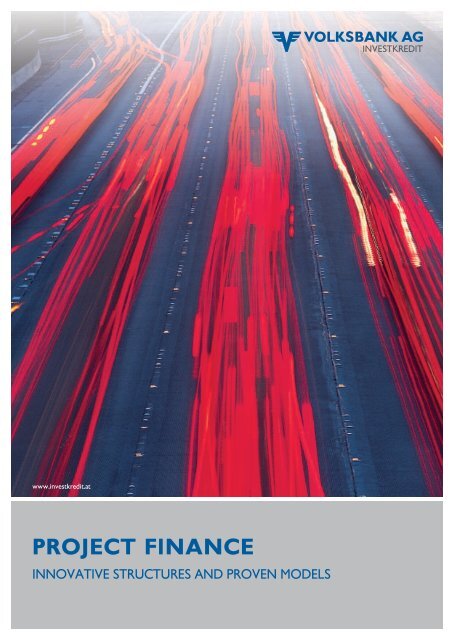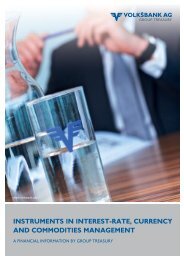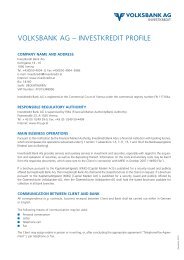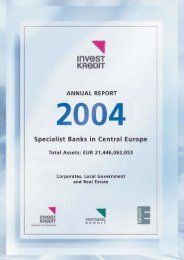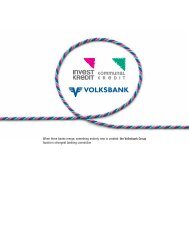Download - Volksbank AG
Download - Volksbank AG
Download - Volksbank AG
Create successful ePaper yourself
Turn your PDF publications into a flip-book with our unique Google optimized e-Paper software.
www.investkredit.at<br />
PROJECT FINANCE<br />
INNOVATIVE STRUCTURES AND PROVEN MODELS
© Robert Polster<br />
Board of Management of <strong>Volksbank</strong> <strong>AG</strong> – Investkredit (left-right): Martin Fuchsbauer, Gerald Wenzel, Michael Mendel and Wolfgang Perdich<br />
VOLKSBANK <strong>AG</strong> – INVESTKREDIT<br />
YOUR PARTNER FOR PROJECT FINANCE<br />
The growing importance of project finance in Europe<br />
reflects the increasing complexity of investment projects.<br />
As different as they are, energy, infrastructure and real<br />
estate projects all have one thing in common: they are<br />
increasingly implemented and financed as project finance<br />
transactions.<br />
Project finance is in demand when classic models of<br />
corporate lending cannot be applied. Typical cases are<br />
projects that are too complex for financing to a standalone-corporation.<br />
A number of partners will come together<br />
in order to pool their respective strengths with the aim of<br />
jointly bearing the various types of risks. Providers of capital<br />
team up in order to base their financing on the profitability<br />
of a project rather than on collateral from the sphere<br />
of the project partners. Against this background, <strong>Volksbank</strong><br />
<strong>AG</strong> – Investkredit sees itself as a competent financier.<br />
As The Bank for Corporates and a as a partner in longterm<br />
investment projects, project finance is a growing<br />
field of business for <strong>Volksbank</strong> <strong>AG</strong> – Investkredit. The<br />
services provided are focused on consulting during the<br />
phase of project planning and on structuring the financing<br />
according to the specific project parameters.<br />
The aim of this brochure is to give an overview of the<br />
instruments and opportunities for cooperation with <strong>Volksbank</strong><br />
<strong>AG</strong> – Investkredit and to indicate typical situations<br />
when project finance is needed. Our specialists will be<br />
pleased to assist you in the structuring and realisation of<br />
your projects.<br />
Talk to The Bank for Corporates about financing your<br />
projects.<br />
3
DIFFERENCES BETWEEN CORPORATE LENDING<br />
AND PROJECT FINANCE<br />
In the context of money and capital markets, the term project<br />
finance refers to a specific discipline of financing. Project<br />
finance is the financing of an asset with the lender primarily<br />
relying on the cash flow from this asset as the source for<br />
the repayment of the financing. The asset itself is the main<br />
collateral. The lender has no or only limited recourse to the<br />
sponsors of the project.<br />
Thus, project finance is also described as “cash-flow based,<br />
limited-recourse (or non-recourse) financing”.<br />
Comparison corporate lending – project finance<br />
Corporate lending<br />
Project finance<br />
Bank<br />
Non-/limited recourse<br />
Bank<br />
Loan<br />
Collateral<br />
Loan<br />
Collateral<br />
Corporates<br />
Corporates<br />
(Sponsors)<br />
Equity<br />
Special Purpose<br />
Company (SPC)<br />
Project<br />
Project<br />
With classic corporate lending, the relationship is directly<br />
between the company and the bank (or, in the case of a<br />
bond, the investors). This is reflected by increased liabilities<br />
on the company’s balance sheet. With project finance,<br />
the financing agreement is signed between the bank and<br />
the special purpose company. The financing is therefore<br />
“off balance sheet” for the project sponsors, who are,<br />
accordingly, not (non-recourse) or only to a limited extent<br />
(limited recourse) liable for the financing.<br />
With corporate lending, the banks usually have a balancesheet<br />
history of the companies which apply for financing.<br />
As a result, credit risks and changes in creditworthiness are<br />
easier to assess. In contrast, the creditworthiness in project<br />
financing is primarily determined by the quality of the<br />
contracts between suppliers, owners, off-takers etc. and the<br />
special purpose company.<br />
One major risk of project finance is the completion risk. The<br />
revenue basis for the repayment of the financing and for the<br />
employment of the funds of the sponsors and investors is<br />
only secured, if a functioning asset is finally taken over for<br />
operation.<br />
4
CONSEQUENTLY, PROJECT FINANCE HAS THE FOLLOWING CHARACTERISTICS:<br />
• Special purpose company<br />
The project sponsors establish a new project company for<br />
the single purpose of realising and financing the project. The<br />
company’s special purpose is exclusively to realise and<br />
administer the investment project. This company acts as the<br />
borrower of the project loans and collects the equity.<br />
• Risk allocation<br />
As part of any risk analysis, the risks associated with the<br />
project are to be identified, comprehensively structured<br />
and then allocated to those parties best suited to bear<br />
the individual risks.<br />
• Lending on cash-flow basis<br />
The financing is repaid from the cash flow of the special<br />
purpose company. The ability for the loan to be repaid<br />
depends on the profitability of the project.<br />
• Off-balance-sheet character<br />
The tangible and intangible assets of the special purpose<br />
company represent the collateral for the financing. The project<br />
sponsors assume no (non-recourse) or only limited<br />
(limited recourse) liability for the project loan. Consequently,<br />
the financing is not recognised in the balance sheet of the<br />
sponsor.<br />
Structure of a project finance transaction<br />
Client/public sector<br />
Concession contract<br />
Direct contractual regulations<br />
Sponsors<br />
Equity<br />
Special Purpose Company<br />
Loan agreement<br />
Banks<br />
Equity<br />
Turnkey<br />
contract<br />
Equity<br />
Financial investor<br />
Operation<br />
contract<br />
Equity<br />
Contractor consortium<br />
(construction company, suppliers)<br />
Operator<br />
5
THE ST<strong>AG</strong>ES OF PROJECT FINANCE<br />
TRANSACTIONS<br />
Project finance transactions usually consist of the following four steps<br />
Financial close<br />
Planning<br />
Construction<br />
Commissioning<br />
Operation<br />
Project team<br />
Feasibility study<br />
Financing package,<br />
Financing model<br />
Offer,<br />
negotiations<br />
Authorisations<br />
(authorities)<br />
Formation of<br />
special purpose company<br />
Completion<br />
Financing<br />
Completion<br />
Supply<br />
Construction<br />
Tests<br />
Handover<br />
Acceptance<br />
Commissioning<br />
Operation<br />
Maintenance<br />
PLANNING<br />
Step 1<br />
The planning phase is very complex due to the parallel<br />
nature of the individual tasks. The result of this phase is a<br />
business plan; its implementation begins in the second phase.<br />
Of crucial importance are the financing plan and the financial<br />
model. In order to ensure the availability of the financing in<br />
good time, it is recommended that banks and investors are<br />
involved as early as possible in the planning process.<br />
COMMISSIONING<br />
Step 3<br />
This phase is a particularly critical part of the project as this<br />
is when the project is accepted by the sponsor and because<br />
the ability to invoice the services is dependent on the full<br />
functionality of the asset. From the bank’s point of view, once<br />
the project has been properly accepted and commissioned<br />
one of the core risks – the completion risk – has been<br />
eliminated.<br />
CONSTRUCTION<br />
Step 2<br />
In the construction phase it is essential to complete the<br />
investment on time, within the planned budget and accord -<br />
ing to the specifications and the functionality laid down<br />
in the construction contract. Initial tests lead to the commissioning.<br />
OPERATION<br />
Step 4<br />
In the operating phase, the asset is managed and continuously<br />
maintained. The generated revenues cover the run -<br />
ning costs and are used to amortise the financing.<br />
6
THE ELEMENTS OF A PROJECT FINANCE<br />
<strong>AG</strong>REEMENT AT A GLANCE<br />
As project finance transactions are mainly cash-flow-oriented, the collateral is derived primarily from the assets of the<br />
project itself. This characteristic is taken into account through contractual features typical for project finance:<br />
• Lender(s)<br />
A bank (or a syndicate of banks led by an arranger)<br />
• Borrower<br />
A special purpose company in which the sponsors hold<br />
shares<br />
• Tenor<br />
Up to 15 years is generally acceptable, longer tenors are<br />
possible; the maturity is usually shorter than the maturity<br />
of the concessions, off-take agreement etc. covering the<br />
project<br />
• Repayment<br />
No repayment of principal during the construction phase;<br />
sometimes tailored repayment schedules<br />
• Interest<br />
Capitalisation of interest during the construction phase can<br />
be agreed; scheduled interest payments during the operation<br />
phase<br />
• Collateral<br />
Collateral, securities and assignment of rights, step-in<br />
rights, etc.<br />
• Financial covenants<br />
These include, among other, debt service coverage ratios<br />
(DSCR), the maintenance of reserve accounts for debt<br />
service (DSRA), major repairs (MRA) and other purposes<br />
• Employment of cash flows<br />
“Waterfall Principle”: Sequence of employment of cash,<br />
i.e. initially covering all direct expenses indispensable for the<br />
operation of the project, lower in priority rank debt service<br />
and, lastly, dividends payable to the sponsors [see chart].<br />
The Waterfall Priciple (cash flow waterfall)<br />
Income<br />
Insurance<br />
Material costs<br />
Operating costs<br />
Maintenance cost<br />
Interest<br />
Repayment of principal<br />
Dividends<br />
7
EXAMPLES OF SUCCESSFUL PROJECT FINANCE<br />
TRANSACTIONS<br />
In order to demonstrate both the variety of suitable targets for project finance and <strong>Volksbank</strong> <strong>AG</strong> – Investkredit’s range of<br />
services as The Bank for Corporates, see below a selection of done deals:<br />
JUNE 2010<br />
AUGUST 2008<br />
CZK 2.217.000.000<br />
and<br />
CZK 250.000.000<br />
Term Loan and<br />
Revolving Credit Facilities<br />
CZK 600.000.000<br />
Financing of<br />
18 MW Windpark<br />
in the Czech Republic<br />
Arranger<br />
Arranger<br />
AUGUST 2007<br />
SOLARIS<br />
MAY 2007<br />
Project Developer<br />
18MW Photovoltaic<br />
Solar Energy Park in Spain<br />
EUR 157.845.000<br />
Senior Secured Financing<br />
EUR 1.520.000.000<br />
Financing of the<br />
takeover and expansion<br />
of Budapest Airport (Hungary)<br />
Co-Arranger<br />
Co-Arranger<br />
OCTOBER 2006<br />
SEPTEMBER 2006<br />
WINDTEX s.r.o.<br />
EUR 6.665.000<br />
Windpark financing in U tří pánů<br />
(Czech Republic)<br />
EUR 110.000.000<br />
Financing of the<br />
construction and operation of a<br />
public safety communication<br />
TETRA radio system in Austria<br />
Arranger<br />
Arranger<br />
8
PUBLIC PRIVATE PARTNERSHIPS (PPP)<br />
Public Private Partnerships are partnerships between the public sector and private enterprises in the provision and financing<br />
of public infrastructure projects. The main purpose of such partnerships is to take advantage of the strengths of the respective<br />
partners. Performance incentives for the private partners are intended to ease the organisational and financial burden of<br />
the public sector.<br />
BACKGROUND<br />
The increasing economic integration in Europe and the<br />
population growth in urban areas are placing enormous<br />
demands on public infrastructure.<br />
Many public infrastructure projects show a high degree of<br />
potential for private business and therefore do not nec -<br />
essarily have to be financed from public sector budgets.<br />
Furthermore, technological risks strongly suggest a transfer<br />
of risk to specialised private enterprises.<br />
Against this background, innovative financing solutions are<br />
required which assess the profitability of a project and, as a<br />
result, optimise the use of public sector funds. From the<br />
viewpoint of financing technique, therefore, project finance<br />
can offer a suitable range of financing instruments to Public<br />
Private Partnerships.<br />
REASONS FOR PPP<br />
Public Private Partnerships can be utilised in practically all<br />
areas of public sector activity. Many Public Private Partnerships<br />
in Europe show that public infrastructure projects<br />
are very compatible with the requirements of private<br />
financing.<br />
In the case of road construction projects, for example, the<br />
public sector transfers the right to construct and to operate<br />
a motorway to a private concessionaire. This company<br />
undertakes the construction, financing and operation of the<br />
route and in return receives the right to levy tolls. Levying<br />
tolls on a route represents direct remuneration for the<br />
performed service and, therefore, a source of private income.<br />
If the toll for political or social reasons has to be limited to an<br />
amount which does not fully cover the costs, the public sector<br />
would be obliged to cover the resulting deficit.<br />
ADVANT<strong>AG</strong>ES OF<br />
PUBLIC PRIVATE PARTNERSHIPS<br />
The advantage of Public Private Partnerships lies in combining<br />
the strengths of the pubic sector with those of private sector<br />
partners, thus creating economic synergies for both sides:<br />
• Cost efficient realisation of projects (construction and<br />
operation)<br />
• Risks borne by those project partners which are most<br />
suited to do so<br />
• Budget relief through the use of private financing sources<br />
and inclusion of the life-cycle costs of an investment into<br />
the financing decision<br />
• New performance incentives for private companies<br />
9
REASONS FOR PROJECT FINANCE<br />
• Renewable energy<br />
Wind, photovoltaics, biomass, biogas,<br />
hydropower,…<br />
• Fossil fuels<br />
Coal, gas,…<br />
• Industries<br />
Construction, utilities, plant engineering,…<br />
• Public sector<br />
– Infrastructure (roads, rail, airports)<br />
– Supply and disposal (water, community heating,<br />
waste water, refuse disposal)<br />
– Structural engineering (schools, hospitals, prisons)<br />
• Telecommunication<br />
VOLKSBANK <strong>AG</strong> – INVESTKREDIT’S SERVICES<br />
IN PROJECT FINANCE<br />
<strong>Volksbank</strong> <strong>AG</strong> – Investkredit, as a specialist for medium- and long-term financing, offers its customers the following project<br />
finance services:<br />
• Structuring of project finance<br />
Arranging<br />
• Participation in project finance<br />
Participations<br />
• Consulting services<br />
Financial advisory<br />
• Technical consulting<br />
in-house, external<br />
• Financial modelling<br />
10
YOUR CONTACTS<br />
JOHANNES SEIRINGER<br />
Head of Project Finance<br />
Tel. +43(0)50 4004 - 4263<br />
Fax +43(0)50 4004 - 84263<br />
johannes.seiringer@investkredit.at<br />
ANDREAS HANDLER<br />
Project Finance, Participations<br />
Tel. +43(0)50 4004 - 4336<br />
Fax +43(0)50 4004 - 84336<br />
andreas.handler@investkredit.at<br />
© Wilke<br />
© Elisabeth Kessler<br />
© Wilke<br />
SONJA JUSZT<br />
Project Finance<br />
Tel. +43(0)50 4004 - 4259<br />
Fax +43(0)50 4004 - 84259<br />
sonja.juszt@investkredit.at<br />
© Michael Sazel<br />
WOLFGANG PAYER<br />
Project Finance<br />
Tel. +43(0)50 4004 - 4262<br />
Fax +43(0)50 4004 - 84262<br />
wolfgang.payer@investkredit.at<br />
BENCE NÁDASDY<br />
© Stefan Badegruber<br />
Project Finance<br />
Tel. +43(0)50 4004 - 4260<br />
Fax +43(0)50 4004 - 84260<br />
bence.nadasdy@investkredit.at<br />
We look forward<br />
to talking to you.<br />
© Aleksandra Pawloff<br />
JUDIT KEREKES<br />
Active Credit Management<br />
Tel. +43(0)50 4004 - 4267<br />
Fax +43(0)50 4004 - 84267<br />
judit.kerekes@investkredit.at<br />
© Aleksandra Pawloff<br />
SYLVIA MEIXNER<br />
Active Credit Management<br />
Tel. +43(0)50 4004 - 4270<br />
Fax +43(0)50 4004 - 84270<br />
sylvia.meixner@investkredit.at<br />
11
IMPRINT<br />
Published by: Investkredit Bank <strong>AG</strong>, 1090 Vienna, Kolingasse 14 - 16, Tel. +43(0)50 4004-0, Fax +43(0)50 4004-3683, invest@investkredit.at, www.investkredit.at;<br />
Editor: Andrea Vitali, Österreichische <strong>Volksbank</strong>en-<strong>AG</strong>, Marketing & Communications, 1090 Vienna, Kolingasse 14 - 16;<br />
Graphic design and production: Dieter Achter, Österreichische <strong>Volksbank</strong>en-<strong>AG</strong>, Marketing & Communications, 1090 Vienna, Kolingasse 14 - 16<br />
September 2010<br />
December 2010


